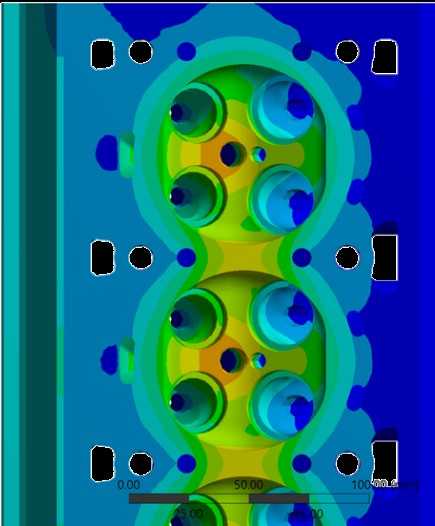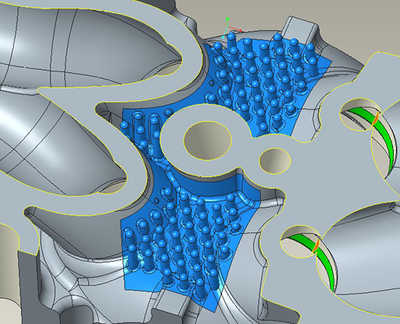Background
The cylinder head is one of the most complex components of the engine, with many requirements in conflict. Cylinder head temperature control is crucial, both to minimize auto-ignition and to ensure adequate fatigue life. Aluminum fatigue strength drops quickly as operating temperatures increase. Thermo-mechanical fatigue failures can include injector bore and spark plug bore cracking, valve bridge cracking and internal water jacket cracking.
Hybrid ceramic-sand core casting is a SwRI-patented technology that enables casting of ultra-small passages (approximately 1.5mm width or diameter). Metal additive manufacturing (AM) can also facilitate extreme feature dimensions of less than 0.4mm [2], but consideration may be needed for thermal expansion or printing supports on larger pieces. In addition, large scale metal AM is not yet cost or time practical for mass production.
Approach
This project develops a parametric cylinder head model and applies boundary conditions from actual test data to make a comparison between the cooling effectiveness of purely sand-cast passages and hybrid passages which can optimize cooling, particularly in down-sized, turbocharged engines. Confirming and quantifying the effectiveness of hybrid-core passages will help Division 03 overcome challenges associated with developing the next generation of automotive engines and will further strengthen SwRI’s position in the marketplace.
The research will also determine the effectiveness that the size and placement of refined cooling passages has on the temperature profile and thermo-mechanical durability of the head. Cooling capability is being analyzed through water jacket design iterations using computational fluid dynamics (CFD). Thermal stresses are being computed using finite element analysis (FEA).

Figure 1: Maximum temperatures from traditional manufacturing exceed design limits.

Figure 2: Temperatures are significantly reduced to safe levels with a hybrid design using an additive manufacturing insert.
Accomplishments
 Figure 3: A printed metal insert featuring cooling pins (blue) is assembled to the cylinder head casting (grey).
Figure 3: A printed metal insert featuring cooling pins (blue) is assembled to the cylinder head casting (grey). The team developed a 1.75L, four-cylinder gasoline direct injection engine with a 0.85 bore-to-stroke ratio. The model also included a central-mounted fuel injector as compared to a traditional side-mounted fuel injector. OEMs are trying to produce engine configurations with a central-mounted fuel injector to increase performance and reduce emissions. This trend towards a centrally mounted vertical injector will further limit the space available for engine coolant flow. Baseline and improved options were analyzed using cooling jacket CFD and thermal FEA simulations.
To reduce temperatures to an acceptable level for maintaining the strength of the aluminum cylinder head, a hybrid cooling passage approach was required, as thermal results showed that even pushing traditional methods of casting to their limits, adequate cooling could not otherwise be achieved. The proposed method for constructing these complex passages is a printed metal insert. Potential benefits of additive manufacturing of engine cooling features is being reviewed in Division 03’s MAKERS IR project. While metal printing technologies continue to mature, future issues for integration into cylinder head development may focus on the thermal and mechanical properties of the printed/cast interface and are the basis for future work in this area.
